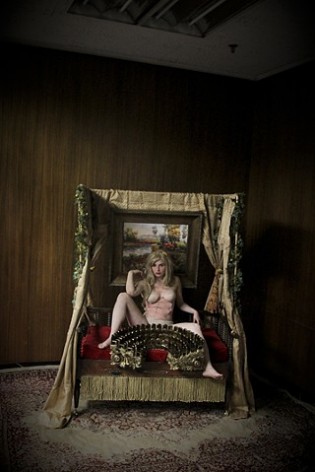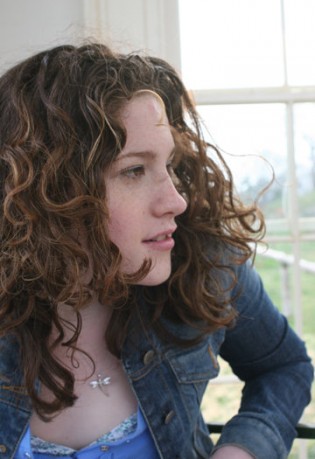Straddling Two Worlds

How Sarah Zell Young relies on ancient Jewish text to create her provocative performance art.
About the artist:
Sarah Zell Young is a passionate Jewish educator and artist, combining traditional text study of biblical and Talmudic sources with contemporary history of the Jewish body, with an emphasis on social justice. She is passionate about reimagining Jewish ritual and empowering people to integrate creativity and ownership into their personal practices. Young recently received her MFA from Hunter College with course work in psychology and education, and she is a graduate of the Rhode Island School of Design with a degree in sculpture and gender studies. In addition to having been an arts fellow at the Drisha Institute for Jewish Education and participating in residencies at the Vermont Studio Center, Young has exhibited work, lectured on ideas, and taught both nationally and internationally. She was an artist-in-residence in 2012 at the Hadassah-Brandeis Institute and is currently an AJWS global justice fellow and has worked for the past year on the streets of New York, providing services to the homeless and teaching ritual object–making classes for children. She has just received a grant from Asylum Arts to study the disposal of holy texts (shaimos) in Israel, and she is excitedly planning her trip.
Tell us about your attachment to Jewish texts, and where that interest came from.
My work has always straddled two worlds. In my first year of my MFA degree at Hunter, I simultaneously received a fellowship at a religious seminary for women, Drisha, where I spent my days studying ancient Jewish texts. During the evening I attended classes at Hunter, studying the arts. I see opportunities to create ritual between the letters on the page/parchment. In the Talmud, the rabbis believed that the Torah was one of six things that existed before the world was created, and that it consisted of black fire written upon white fire. Black fire is the concrete, the words that do not change; white fire is the space between the letters on the page where revelation is able to continuously transpire. Black fire is the finite, the quantifiable tangible world around us; white fire is the metaphysical, the interpretative or transformative, where a pretty picture becomes a powerful piece of art. It is the ability to see the divine when one looks at his/herself in the sometimes-cloudy mirror. My artwork attempts to create a context for this reflection.
In your art, you like to look at the contemporary female Jewish body. What conclusions, if any, have you drawn?
I became specifically interested in the interaction of religion and the body. I began to develop ideas that combined a traditional text study of biblical and Talmudic sources with a contemporary understanding and experience of the body. I took this amalgamation and began to make artwork, performing the union and the disjuncture using my flesh, often bringing my work into the realm of performance, which has led to my current studio practice. In our tradition, where the female body is sometimes forced to interface with God without agency, I am working on finding agency for myself and other women through my work.
In one of your performance pieces, you drank 72 glasses of water, with each glass containing one of the 72 kabbalistic names of God. Explain your intention, please.
The ritual of the Sotah tells a story of guilt and jealously. The text provides instruction on conducting a trial by ordeal when a husband suspects his wife of adultery. In this case, the husband could bring his wife to see the high priest. The priest would then dissolve special holy earth and written Hebrew incantations, containing the name of God, in water and make the wife drink it. The presence of God dissolved in the water was the ultimate judge, there to prove or disprove the woman’s guilt. If she were innocent, no change in her body would occur. But if she were guilty, her stomach would explode and she would die. In this account, the female body becomes the vehicle of narrative, and her stomach the courtroom where life and death are decided.
Perhaps it is this religious legacy that has set the stage for the modern struggle, so well articulated by Barbara Kruger’s famous edict, “Your body is a battleground,” to mean that the body is the real place in which struggle occurs. My work has shifted to address not only the actual struggle over and within the body, but also to dissect charged religious issues using the body as a metaphor to tell a bigger story.
So how did you go about the performance part? It sounds so brutal.
I performed the story of the Sotah using influence from the Kabbalah, a body of mystical Jewish teachings based on an interpretation of the Hebrew Scripture as containing hidden meanings. In Kabbalah, there are said to be 72 names of God that together make up one great 216-letter name of God. In the performance, I placed around me in a circle, 72 full glasses of water and dissolved in each one a name of God. I then began the struggle to drink all 72 glasses of water, a very difficult task. As I continued the drinking, and spilling water, my body was revealed through the white garment I was wearing as it became wet. This created interplay among my body, God, and the inherent shame of this ritual. When the capacity of my stomach reached its peak, I would vomit, covering myself and the surrounding areas with refuse from my stomach. At the end of the performance, there I was, lying in a pool of my own watery vomit, the profane, but I had also consumed and therefore incorporated all 72 names of God into my being, the sacred, which I again expelled in a never-ending cycle. I tried to make my body a reliquary, stomach containing all of god’s holy names, but ultimately failed in the task.
Did you engage with the audience at all? What was it like to have them watch you go through this journey?
It was difficult both psychologically and physically to complete this piece. I preformed this piece twice – once in Mexico City and once in New York. It seemed as if women viscerally could not watch me perform this piece, while men, on the other hand, were transfixed on my body in struggle. (I have a belief the female body in struggle has been eroticized.) My Sotah performance laid claim to the text, and for a brief moment, I felt like an active agent of change, but looking back, reflecting on the process, I am not so sure I would do it again. I put my body in a dangerous situation to perform this struggle. How can that be sacred? There was a problem with my logic; I was fighting for holiness, something that everyone inherently has, when in fact all I needed to do was fight man’s characterizations of what is holy and what is profane.
During your HBI residence, you created a site-specific installation – a participatory rendition of the Sanhedrin (rabbinic court). Where did that idea come from, and what feelings were you hoping to evoke?
I wanted to create a place of communal ownership over history. While one can’t change history, one can transform its legacy. To this end I wanted to re-create and re-imagine the Great Sanhedrin, where male bodies traditionally occupied the space of justice, fulfilling their roles as arbiters of justice in the court into a place where female bodies could own their own histories. I made a space for the scholars at the Hadassah-Brandeis Institute to sit together in this created sacred space. Together as a community they formed their own council of justice that is relevant for their own lived experience. Each woman’s narrative became instrumental in revealing the space for personal agency between the Hebrew letters on the page and introduced the active author into the historical Sanhedrin subject.
What are you working on now?
I am very interested in shaimos. Jewish Law prohibits the destruction of any piece of writing, which contains the name of God, or any Torah concept. A piece of paper or parchment that fits these parameters must be buried or stored in a genizah (a storage space in Jewish synagogue or cemetery). These holy remnants that are discarded are called shaimos (translated, this word means “names”), or referred to in Israel as genizah. In Psalms it is written: “The stone that the builders rejected has become its cornerstone,” taken to mean that there is profundity in what we try to dispose of or bury under the surface, that there is salvation to be found within what is pushed away from our immediate spheres of being. By reclaiming what is cast aside and disposed of, we can begin to take on what has been lost in this process and begin to find redemption instead.
So how will you explore this idea further? Are there modern themes to this old idea?
The laws of shaimos were promulgated at a time when printed material was precious and rare. This prescribed doctrine does not take into account our age of mass media, Xerox machines, and printers where God’s name can be multiplied a thousand-fold in a matter of seconds, creating more “holy trash” than one knows what to do with. With the proliferation and accumulation of all of these holy names, the disposal of shaimos has become a profitable industry in which services can be bought to dispose of your superfluous holy trash, which can, and sometime does, lead to corruption. Recently there have been controversies with the disposal of shaimos in the New York area. Last year, several thousand trash bags filled with sacred texts appeared on the side of a road in Lakewood, New Jersey, after residents paid to have their shaimos disposed of properly by a rabbi, and this year a similar situation of bags illegally dumped popped up in Haverstraw, New York. A scandal broke out about fraudulent shaimos collection and burial operations in Brooklyn. Israel is a land of both biblical tradition and high-tech industry. There is a great demand for proper disposal of holy names and also an abundance of holy names produced due to modern technology. I just got funded to go to Israel and do research on how shaimos is both properly and improperly disposed of in that country. Examining the methods of how society, both religious and secular, disposes of the huge amount of holy names will expose a bridge between these two worlds that can only be found in the garbage of God.
There are no comments yet, add one below.





Leave a Comment